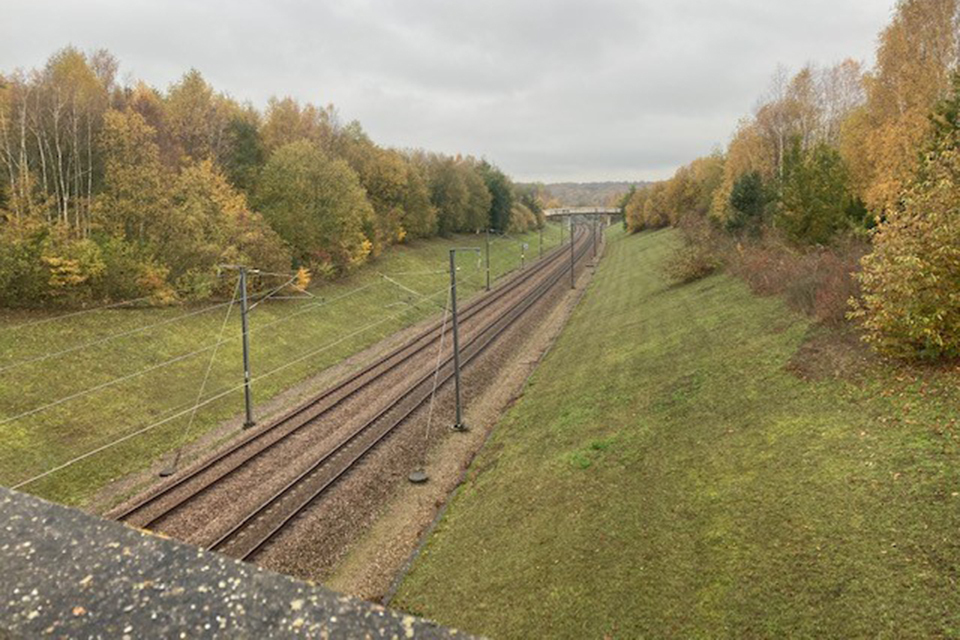Summary
At about 04:15 on 16 November 2023, an on-track machine driver was injured while coupling a multi-purpose vehicle (MPV) to a tamper on the High Speed 1 (HS1) line near Strood, in Kent. The tamper, which had been stationary, moved and struck the driver after a second MPV collided with the other end of it at a speed of about 20 km/h (12 mph). This second MPV was being driven towards the tamper with the intention of coupling all three vehicles together at the end of a night shift.
RAIB’s investigation found that it had become normal practice for this coupling operation to be undertaken with another vehicle approaching the other end of the tamper. The established method of working was for the approaching vehicle to come to a stand at a ‘holding point’ situated around 50 to 100 metres away from the stationary vehicles. The final movement would then be made at very slow speed and under control of the driver responsible for the coupling operation.
However, on this occasion the second MPV did not stop at the holding point. This was because the driver propelling (reversing) the second MPV did not have a view of the railway in the direction of travel of the vehicle and was reliant on radio messages from a machine controller at the rear to know when to slow or stop the vehicle. On the night of the accident, the radio being used by the machine controller had developed an intermittent fault, which led to a breakdown in communication with the driver. Due to the design of the radio, neither the driver nor the machine controller were initially aware that communications had been lost. Although the machine controller subsequently realised that the radio was not working and alerted the driver that they needed to brake by a shouted warning, this occurred too late to avoid the collision.
RAIB found that the type of radios being used during the movement did not transmit a constant ‘confidence tone’ which would have alerted staff to the loss of communications. It was also not normal practice for machine controllers to communicate constantly on long transit moves. In addition, RAIB found that the type of MPVs used on HS1 were not fitted with any facility for machine controllers riding on the rear deck to brake the vehicle, despite an internal recommendation to fit this facility after a previous similar accident in 2021.
An underlying factor in this accident was that Network Rail High Speed, the infrastructure manager for HS1, did not have safe systems of work for propelling moves or working on track when engineering vehicles were running during a possession. A possible underlying factor was that the strategic safety assurance undertaken by HS1 Ltd, which has the concession to operate HS1, did not identify that the recommendation to fit a braking facility to the rear deck had been closed with no actions being taken.
Since the accident, Network Rail High Speed has fitted its MPV fleet with emergency stop buttons adjacent to the rear deck, secure communications systems and is due to install a rearwards-facing camera, connected to an in-cab monitor.
Recommendations
RAIB has made four recommendations. The first three are addressed to Network Rail High Speed and the fourth to HS1 Ltd. The first recommendation aims to control the risks of engineering vehicle operation on HS1, while the second looks to keep staff working on the line safe by implementing a robust procedural framework. The third recommendation is that Network Rail High Speed ensures that internal recommendations and local actions are reviewed and implemented in a way that reflects their intent, and in a way that can be tracked and used to support safety decision‑making. The final recommendation is for HS1 Ltd to exercise effective strategic safety assurance of its suppliers.
Notes to editors
-
The sole purpose of RAIB investigations is to prevent future accidents and incidents and improve railway safety. RAIB does not establish blame, liability or carry out prosecutions.
-
RAIB operates, as far as possible, in an open and transparent manner. While our investigations are completely independent of the railway industry, we do maintain close liaison with railway companies and if we discover matters that may affect the safety of the railway, we make sure that information about them is circulated to the right people as soon as possible, and certainly long before publication of our final report.
-
For media enquiries, please call 01932 440015.


